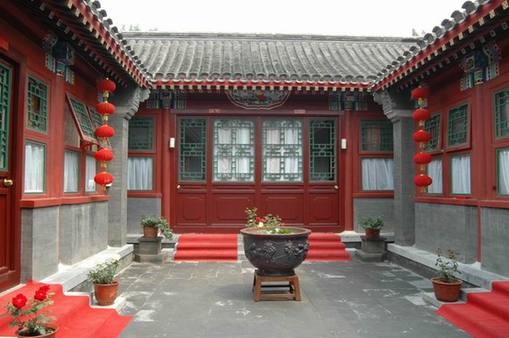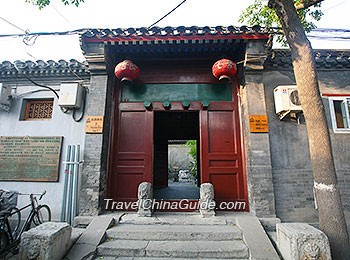(VOVWORLD) - Siheyuan, a word that means “quadrangle” in Chinese, refers to a traditional Chinese compound. For 2,000 years, the quadrangular compound has been considered a template for Chinese architecture. In this week’s “Cultural Rendezvous”, Qing Duo, a former correspondent for China Radio International and now a blogger, will tell us about Beijing’s siheyuan.
 Beijing's Siheyuan represents the capital's architectural style. (File photo: china.org.cn) Beijing's Siheyuan represents the capital's architectural style. (File photo: china.org.cn)
|
Bao Tram: Hi, Duo! Thank you for joining us. As a blogger, you’ve made a lot of videos about Beijing, your hometown. What exactly do you tell your audience?
Qing Duo: Hi, Tram. Thank you for having me here to share with you about Beijing, my hometown. I finished my work in Hanoi in July, 2021, and went back to Beijing. Because of the epidemic, I can't travel around like I did before, so I started making videos about Beijing. There is a lot of new fun stuff in Beijing, as well as many cultural exhibits. I’m not an expert in Beijing culture, I just want to introduce Beijing to others from my own perspective.
Bao Tram: Visitors to Beijing are often advised to explore siheyuans, considered an important cultural element of the capital city. So what are the siheyuans?
Qing Duo: Siheyuan, the traditional Chinese courtyard house, is the residential architecture of Northern China. The basic layout of the siheyuan is four houses enclosing a quadrangular courtyard, hence the name siheyuan. The four houses include the main house, two wing houses, and the opposite house.
Bao Tram: So there are the rules for building a siheyuan, I guess.
Qing Duo: A siheyuan is a typical form of ancient Chinese architecture, especially in the north of China. They are designed to make it as comfortable as possible to live in a climate that is at times inhospitable. For instance, the siheyuans are enclosed and inward-facing to protect them from the harsh winter winds and the dust storms of spring. The design also reflects the traditions of China, following the rules of Geomantic omen and the patriarchal, Confucian tenants of order and hierarchy that were so important to society.
From the layout and construction, a siheyuan is typically symmetrical, pays attention to the differentiated exterior and interior, humble and noble, and loses touch with the outside world to enjoy tranquility and share the happiness of a peaceful family union.
The gate is the main entrance and exit, which is designed in southeast of the entire siheyuan. Social status can be best reflected in the gate.
 The gate of of a siheyuan (Photo: travelchinaguide.com) The gate of of a siheyuan (Photo: travelchinaguide.com)
|
Bao Tram: Wow, it means that just passing by a siheyuan, we’ll know who live there, right?
Qing Duo: Generally speaking, the gate is divided into six levels according to the social status of the host: Wangfu gate; Guangliang Gate; Jinzhu Gate; Manzi Gate, Ruyi Gate and Qiangyuanshi Gate. Wangfu, which means royal gate is the highest rank of all. Guangliang Gate showed that it was the house of ancient officials. Jinzhu Gate was also for officials, but the level was inferior to Guangliang Gate. Manzi Gate was for ordinary people. Ruyi Gate was lower than Manzi Gate and Qiangyuanshi Gate, which was widely used among ordinary family. All the gates are painted red, a symbol of luck in China.
Bao Tram: As a Beijing citizen, do you live in a siheyuan?
Qing Duo: I live in Beizongbu Hutong in Dongcheng district of Beijing, but not in a siheyuan. There are many siheyuans near my apartment, some are former residences of celebrities and have been protected, and some were renovated. A siheyuan is now no longer an affordable place for everyone. Those who can afford the siheyuans must be billionaires.
Bao Tram: So now only a few Chinese people are living in siheyuans because they are too expensive, or are there any other reasons?
Qing Duo: With a population of over 20 million, Beijing is a super metropolis, and the number of siheyuans is limited. Most people have to live in apartments. Moreover, those old siheyuans that have not been transformed are actually uncomfortable to live in.
Bao Tram: How the siheyuans have been transformed?
Qing Duo: Now many siheyuans in Beijing have been transformed into cafes, restaurants or hotels, and some even have opened the roof area. You can sit on the roof and look at the city while enjoying a cup of coffee. There are many such restaurants in famous scenic spots like Nanluoguxiang and Houhai. There are also many art galleries and museums in siheyuan. For example, in the Dongsi Hutong Museum, the rooms there still retain the style of the past, and there are many collections that are closely related to the life of old Beijing.
Bao Tram: If I come to Beijing, do you think a half-day tour of hutongs, which are narrow streets or alleys, and siheyuans is enough? Where should I visit?
Qing Duo: There are many options for traveling in Beijing. Many hutongs and siheyuans are located around Beijing’s famous attractions, such as the Forbidden City, Qianmen, and Houhai. If you come here for only half a day, I think I’ll take you for a walk around Houhai. Houhai is an artificial lake that was transformed from the accumulated water in the city during the Yuan Dynasty. There are many former residences of celebrities which are sihyuans in the surrounding area, and there are also many hutongs all over. There are also many great restaurants and tea houses there. If you spend half a day here, I’m sure you will have a wonderful time.
Bao Tram: Thank you so much, Duo, for joining us today and telling us about siheyuan, a cultural feature of Beijing since ancient times.
Qing Duo: I really enjoyed talking with you. Thank you.